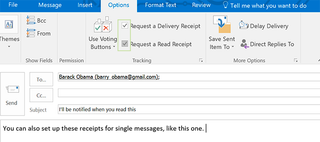

This can happen for several reasons and the Zendesk Operations team is always interested to discover a listing with any listing service, for example, RBL, SORBS, or DNSBl. Less likely, though still an occasional issue, is when Zendesk's servers become blocked.

The recovery action will send a message to the email service that they wish to receive emails from this sender. Have the user click on the "Not spam" button to recover the email to the inbox. They generally do a good job at this, but it is not uncommon to find a missing email in the spam folder when it should have arrived in the inbox. These email services receive more traffic, so their spam filters have to be tuned differently than when an email arrives from a single recognized domain.
OUTLOOK READ RECEIPT EXTERNAL EMAILS FREE
The other half of that key is provided by your domain so when those keys match, the likelihood that the email will be accepted is greatly increased, as confidence in the email receipt is verifiable.Īn additional variable in this equation occurs when you are sending to one of the free online email services, for example, Gmail, Yahoo, and MSN. This protocol performs a very similar role, except that it signs the outbound email with an encrypted key. Marketing departments typically expect unsolicited emails from a much wider variety of vendors and contacts.Īn alternative to having an SPF record is DKIM. For example, the likelihood of reaching the CEO is not the same as reaching somebody in the marketing department. This can occur because there are cascading permissions and security settings within any server environment of a company. Sometimes an email will arrive as expected at the inbox of one member of a company, but not at another. An SPF record asks the recipient server to lower their spam score for this transmission because you are aware and you want Zendesk to act on your behalf. For example, when an email arrives at another server from an IP outside of your domain, they run a quick check to make sure that you are aware of this and that you approve the process. SPF records are a listing that permits Zendesk to send an email as if Zendesk were you. Notifications of these unauthorized notifications may only encourage you to try a different way.įor Zendesk to send an email on your behalf, it is recommended to establish an SPF record as part of your domain's DNS record. The reason for this is that if a server suspects that you are trying to get unauthorized communications to somebody within their organization, they will suspend, reject, or route your email to a spam folder without notification.

Depending on how the recipient server is configured, you may or may not receive a bounce-back notification in your suspended queue. If your emails are not delivered to a specific domain, it is likely that they are being blocked as spam. Problems with sending email to a specific domain or user Problems with sending email to a specific domain or user.This article covers some of the more common issues related to email deliverability in Zendesk Support. The open nature of email as a communication protocol suggests that it will very likely always represent a problem. Luckily, these systems can be self-correcting and some steps can be taken to assist them in the difficult job that they do. This makes it increasingly difficult for them to effectively do their jobs without occasionally suspending a legitimate email along the way. With a proliferation of spam emails, an increasing number of ISPs were forced to implement more stringent restrictions on delivery, as well as focus more on filtering out spam traffic. Many servers don't provide these as part of an effort to provide potential spammers with as little information as possible about their internal processes. Occasionally, a server provides a bounce-back" email, letting the sending server know that the email can not be delivered and why. Additionally, once the relay server accepted the email for delivery there are several things that may prevent the email from making its way to the recipient. Delivery is based on assumption and acceptance by the relay server to complete the function. This means that there is no guarantee that any email sent from you will be delivered to its intended recipients. Email is commonly used as a non-confirming message delivery protocol.


 0 kommentar(er)
0 kommentar(er)
